AAO-NANOS Neuro-Ophthalmology Clinical Collection: Derived from the AAO-NANOS Clinical Neuro-Ophthalmology collection produced on CD. The images are of selected cases from the NANOS teaching slide exchange, and the CD was produced under the direction of Larry Frohman, MD and Andrew Lee, MD.
The American Academy of Ophthalmology (AAO); The North American Neuro-Ophthalmology Association (NANOS).
NOVEL: https://novel.utah.edu/
TO
Filters: Collection: "ehsl_novel_aao_nanos"
| Title | Creator | Description | ||
|---|---|---|---|---|
| 51 |
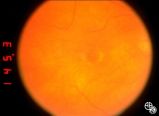 |
Neuro-Ophthalmic Consequences of Therapy | Don Bienfang, MD | An elderly woman was first seen in 1991, after being on Plaquenil (Hydroxychloroquine Sulfate) for 5 to 6 years, with a new symptomatic disturbance in her reading. Because her blue/yellow color perception was disturbed, and because she had symptoms, the medication was stopped. However the fundi and ... |
| 52 |
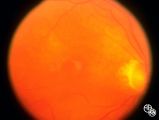 |
Neuro-Ophthalmic Consequences of Therapy | Don Bienfang, MD | An elderly woman was first seen in 1991, after being on Plaquenil (Hydroxychloroquine Sulfate) for 5 to 6 years, with a new symptomatic disturbance in her reading. Because her blue/yellow color perception was disturbed, and because she had symptoms, the medication was stopped. However the fundi and ... |
| 53 |
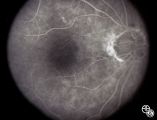 |
Neuro-Ophthalmic Consequences of Therapy | Don Bienfang, MD | An elderly woman was first seen in 1991, after being on Plaquenil (Hydroxychloroquine Sulfate) for 5 to 6 years, with a new symptomatic disturbance in her reading. Because her blue/yellow color perception was disturbed, and because she had symptoms, the medication was stopped. However the fundi and ... |
| 54 |
 |
Neuro-Ophthalmic Imaging-MRI | Don Bienfang, MD | A 59-year-old untreated hypertensive man had a sudden onset of vomiting, gait ataxia, dysarthria, and left-sided weakness. The eyes were deviated downward and to the left. (Note position of gaze in 94_11). Extraocular motility was full. There was rotary nystagmus with the fast phase to the left; the... |
| 55 |
 |
Trochlear Motility Disturbances | Don Bienfang, MD | This patient displays a posttraumatic left fourth nerve palsy sustained after having struck her head on the dashboard. |
| 56 |
 |
Motility Disturbances | Eric L. Berman, MD | This is a 60-year-old albino woman with chronic progressive external ophthalmoplegia and strabismus fixus. Her extreme bilateral esotropia caused her acuity to be 20/400 OU, no view of fundus could be obtained except for the far periphery. CPEO is the most common manifestation of mitochondrial myopa... |
| 57 |
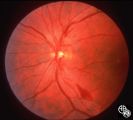 |
Isolated Hereditary Optic Neuritis/Neuropathy | Gregory S. Kosmorsky, MD | Leber's hereditary optic neuropathy is a mitochondrial hereditary optic neuropathy that usually affects young males but may occur at any age and in males or females. The clinical features are usually acute bilateral simultaneous or sequential visual loss with a central acuity and central visual fiel... |
| 58 |
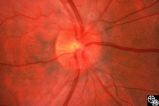 |
Isolated Hereditary Optic Neuritis/Neuropathy | Gregory S. Kosmorsky, MD | Leber's hereditary optic neuropathy is a mitochondrial hereditary optic neuropathy that usually affects young males but may occur at any age and in males or females. The clinical features are usually acute bilateral simultaneous or sequential visual loss with a central acuity and central visual fiel... |
| 59 |
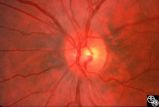 |
Isolated Hereditary Optic Neuritis/Neuropathy | Gregory S. Kosmorsky, MD | Leber's hereditary optic neuropathy is a mitochondrial hereditary optic neuropathy that usually affects young males but may occur at any age and in males or females. The clinical features are usually acute bilateral simultaneous or sequential visual loss with a central acuity and central visual fiel... |
| 60 |
 |
Ocular Manifestations of Congenital/Inherited Diseases | Jacqueline A. Leavitt, MD | This 22-year-old woman has neurofibromatosis, type 2. Acuity, color plates, pupillary responses, slit-lamp examination, IOP, fields, and funduscopy are all normal. There is a 3 mm proptosis OS. The patient has recently undergone gamma knife for the acoustic tumor, and she has residual facial nerve p... |
| 61 |
 |
Neuro-Ophthalmic Manifestations of Brain Tumors | Jacqueline A. Leavitt, MD | Chordomas of the clivus may result in diplopia due to a sixth nerve palsy. The sixth nerve runs up the clivus and may be the presenting manifestation of the lesion. Pair with Images 97_33, 97_34, and 97_35. |
| 62 |
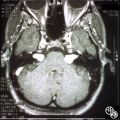 |
Ocular Manifestations of Congenital/Inherited Diseases | Jacqueline A. Leavitt, MD | This 22-year-old woman has neurofibromatosis, type 2. Acuity, color plates, pupillary responses, slit-lamp examination, IOP, fields, and funduscopy are all normal. There is a 3 mm proptosis OS. The patient has recently undergone gamma knife for the acoustic tumor, and she has residual facial nerve p... |
| 63 |
 |
Neuro-Ophthalmic Vascular Disease | Jacqueline A. Leavitt, MD | Arteriovenous malformations are dysplastic vascular channels. They may result in neuro-ophthalmologic findings from direct compressive effects, secondary hemorrhage, or secondary seizure disorder. CT and/or MRI may demonstrate the lesion, but cerebral arteriography is usually required to better defi... |
| 64 |
 |
Ocular Manifestations of Congenital/Inherited Diseases | Jacqueline A. Leavitt, MD | This 22-year-old woman has neurofibromatosis, type 2. Acuity, color plates, pupillary responses, slit-lamp examination, IOP, fields, and funduscopy are all normal. There is a 3 mm proptosis OS. The patient has recently undergone gamma knife for the acoustic tumor, and she has residual facial nerve p... |
| 65 |
 |
Ocular Manifestations of Congenital/Inherited Diseases | Jacqueline A. Leavitt, MD | This 22-year-old woman has neurofibromatosis, type 2. Acuity, color plates, pupillary responses, slit-lamp examination, IOP, fields, and funduscopy are all normal. There is a 3 mm proptosis OS. The patient has recently undergone gamma knife for the acoustic tumor, and she has residual facial nerve p... |
| 66 |
 |
Ocular Manifestations of Congenital/Inherited Diseases | Jacqueline A. Leavitt, MD | This 22-year-old woman has neurofibromatosis, type 2. Acuity, color plates, pupillary responses, slit-lamp examination, IOP, fields, and funduscopy are all normal. There is a 3 mm proptosis OS. The patient has recently undergone gamma knife for the acoustic tumor, and she has residual facial nerve p... |
| 67 |
 |
Neuro-Ophthalmic Manifestations of Brain Tumors | Jacqueline A. Leavitt, MD | Chordomas of the clivus may result in diplopia due to a sixth nerve palsy. The sixth nerve runs up the clivus and may be the presenting manifestation of the lesion. Pair with Images 97_34, 97_35, and 97_36. |
| 68 |
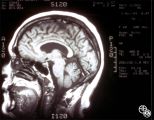 |
Neuro-Ophthalmic Manifestations of Brain Tumors | Jacqueline A. Leavitt, MD | Chordomas of the clivus may result in diplopia due to a sixth nerve palsy. The sixth nerve runs up the clivus and may be the presenting manifestation of the lesion. Pair with Images 97_33, 97_34, and 97_36. |
| 69 |
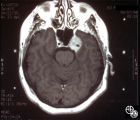 |
Neuro-Ophthalmic Manifestations of Brain Tumors | Jacqueline A. Leavitt, MD | Chordomas of the clivus may result in diplopia due to a sixth nerve palsy. The sixth nerve runs up the clivus and may be the presenting manifestation of the lesion. Imaging: MRI, T-1 axial with contrast. Pair with Images 97_33, 97_34, and 97_36. Anatomy: Clivus, Sixth nerve. Pathology: Sixth nerve p... |
| 70 |
 |
Pupillary Syndrome | Jeffrey G. Odel, MD | Intermittent dilation of the pupils may occur as a benign phenomenon in healthy young adults. In the absence of other third nerve signs, (eg, ptosis, diplopia, ophthalmoplegia), an isolated transient dilation of the pupil in an otherwise healthy adult is unlikely to represent a third nerve palsy. Tr... |
| 71 |
 |
Pupillary Syndrome | Jeffrey G. Odel, MD | Intermittent dilation of the pupils may occur as a benign phenomenon in healthy young adults. In the absence of other third nerve signs, (eg, ptosis, diplopia, ophthalmoplegia), an isolated transient dilation of the pupil in an otherwise healthy adult is unlikely to represent a third nerve palsy. Tr... |
| 72 |
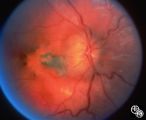 |
Isolated Congenital Optic Disc Anomalies | Joel M. Weinstein, MD | This 8-year-old boy presented with a 2-week history of decreased vision in the right eye. He had undergone a normal MRI and CSF examination, including intracranial pressure, before neuro-ophthalmologic assessment. The fundus photographs and fluorescein angiograms show subretinal neovascularization a... |
| 73 |
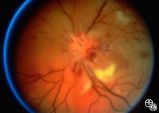 |
Neuro-Ophthalmic Consequences of Therapy | Joel M. Weinstein, MD | The patient is a 38-year-old woman with oligodendroglioma of the left cerebral hemisphere. The patient received intracarotid BCNU and developed BCNU retinopathy, optic neuropathy, and partial ophthalmoplegia. Image 92_21is from 1 month later and demonstrates hemorrhagic swelling of the disc, retinal... |
| 74 |
 |
Neuro-Ophthalmic Consequences of Therapy | Joel M. Weinstein, MD | The patient is a 38-year-old woman with oligodendroglioma of the left cerebral hemisphere. The patient received intracarotid BCNU and developed BCNU retinopathy, optic neuropathy, and partial ophthalmoplegia. Image 92_22 Shows late changes, with more severe retinal ischemia, vascular attenuation, an... |
| 75 |
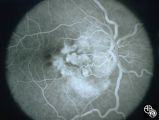 |
Pseudopapilledema With Subretinal Neovascularization on Fluorescein Angiogram | Joel M. Weinstein, MD | This 8-year-old boy presented with a 2-week history of decreased vision in the right eye. He had undergone a normal MRI and CSF examination, including intracranial pressure, before neuro-ophthalmologic assessment. The fundus photographs and fluorescein angiograms show subretinal neovascularization a... |
